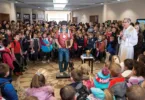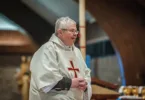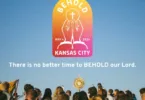New St. James Church dedicated in Wetmore
by Joe Bollig
joe.bollig@theleaven.org
WETMORE — They didn’t have to say anything. Their faces said it all.
Lit with joy, parishioners entered the new St. James Church in Wetmore for the first time on April 10 for the dedication Mass.
After 40 years of worshipping in the provisional space of a converted school, they finally had a “real” church of their own. Their exodus was over. They were finally home.
“We’re very excited, and it means a lot to us to have something designed and dedicated for Mass,” said Bill Burdick, parish finance committee chairman.
“People were so energized and excited about the project,” he continued. “When we were building it and coming to the end, people came by on almost a daily basis to check the progress. You almost had to keep them away because they were so excited about it.”
Ground was broken for the new church on Sept. 5 last year. Parishioners dug out the basement themselves with a backhoe and carried away the dirt in farm trucks. The church was built by Frank Engelken, general contractor of F&L Construction of Centralia. He finished the last details the day before the Mass.
The liturgy began with an honor guard of fourth-degree Knights of Columbus, with members drawn from various assemblies from Seneca to Atchison, leading the clergy and people up the steps to the front door.
Parishioner Lynn Grollmes handed a wooden box with the front door key to Archbishop Joseph F. Naumann, who, in turn, handed it to the pastor Father Balachandra Miriyala, who opened the door.
The church, with a seating capacity of 320, was nearly full. Some people watched the Mass via closed-circuit television in a temporary overflow section in the basement.
The main celebrant and homilist was Archbishop Naumann. He was joined at the altar by Abbot Barnabas Senecal, OSB, of St. Benedict’s Abbey in Atchison; former pastor Father Kent O’Connor, now pastor of Our Lady of Unity in Kansas City, Kan.; and Father Miriyala. Msgr. Gary Applegate was master of ceremonies.
In his homily, Archbishop Naumann congratulated Father O’Connor for beginning the new church project and Father Miriyala for finishing it. He thanked parishioners for their hard work and faithfulness in building the church.
The archbishop also talked about the symbolism of a church dedication, and of the church itself.
“In our Catholic tradition, we strive to built beautiful churches,” said the archbish- op. “And we do this not as some act of pride, because we want our churches to look better than anyone else’s, but we do this because of what takes place here.”
“[A Catholic church] is not just a gathering place,” he continued. “It’s not even just a prayer room. It is a place where God makes himself present to us in a unique and most powerful way.”
“It doesn’t matter how our church compares to someone else’s church, but it is the best expression we can make of our desire to show our love, our honor, our gratitude to God for making himself so available to us,” he said. “And our churches remind us of our own dignity as well.” Following the Mass, Archbishop Naumann blessed the five classrooms, common area, pastor’s overnight room, bathrooms, and storage rooms in the church basement. A dinner was held in the parish hall after the blessings.
The new St. James Church is a wood-frame structure faced with red brick. It has a short steeple over the main entrance. At the front, on the north side, is a white steel-frame bell tower with the original 1895 bell, brought over from the older church.
The 50-by-90-foot church is oriented east to west, with the entrance to the west. The sanctuary is handicap accessible, with ramps to the front door and a ramp in the breezeway at the back on the north side. The basement is handicap accessible from the parish hall, as well as through a walk-out on the south side.
The church has a total of 9,000 square feet, evenly divided between the sanctuary and the basement.
The church features a cathedral ceiling with faux wooden beams. The interior is painted white with blue-gray carpet. The altar has white tile with black tile trim. At the back is a gathering space, reconciliation room, cry room and bathrooms. A breezeway connects the church to the parish hall.
Parishioners cut down and refinished the pews themselves, which were bought from St. Michael the Archangel Parish in Leawood.
The Stations of the Cross, which also came from Leawood, were so badly damaged that they were almost deemed unusable, but artisans from St. Joseph, Mo., restored them. Two statues are on order from Italy.
Several liturgical furnishings, including the altar from the old church, built in the 1950s by Benedictine monks from Atchison, were brought to the new church. The tabernacle was placed on the old altar. Don Tanking built a new wood ambo; Jason Tanking built a new wood altar. Regis Feldkamp, from Seneca, built a new ambry for the holy oils and frames for the stained-glass windows.
The church now has three stained-glass windows of the planned 15, from the Missouri Leaded Glass Company.
The octagonal window over the altar, which depicts the calling of St. James by Christ, was dedicated to Father Kent O’Connor. Two back-lit windows flanking the altar are dedicated to the memory of Alan Bloom, a 16-year-old parishioner who died in a car accident about a year ago.
The remaining windows, which will be installed as inserts, are already paid for but have not been finished. Other parts to be finished later are a drop-ceiling in the basement and landscaping.
Parishioners wanted to remodel their former church or build a new church for many years, but there was a lot of uncertainty about the future, said Father Miriyala. It was determined that remodeling or adding onto the existing church, a former school building that had been remodeled in 1969, would be very costly.
“We sent out a survey [of parishioners], and 98 percent came back in favor of a new church,” said Ron Burdiek, finance committee chairman and project coordinator. “When we asked for pledges, 98 percent sent money, and now it’s up to 99.5 percent.”
This was a turnkey project, meaning the general contractor did most of the work. However, parishioners and former parishioners contributed in various ways. Even non-Catholics in the community contributed.
“In the beginning I wondered if we would get enough money, and I had a lot of worries,” said Father Miriyala. “I told them to keep within the limits of the budget. But the people were so excited, so I was also excited, seeing their energy.”
The cost of the project was about $465,000, of which $310,000 has been raised. Burdick said the remainder will be paid off in three years.
“It looks really good at this point,” he said. “We are rural, and have an agricultural-based economy. Once we make commitments, we stick to them.”
Tim Rowland, a former parishioner now living in Platte City, Mo., donated his work in drawing the plans for the church. This project was unusual in that it is probably the only archdiocesan project that did not have an architect.
“I don’t think that there has been a parish that came together, cooperated, and finished in this short a time frame,” said Rowland. “I think it says a lot about the people in the parish. There’s an outstanding will and determination here.”
Members of St. James Parish, with only slightly more than 70 households, see this new church as a symbol of their desire to pass on a strong faith to their children.
“This will be the third church I’ve gone to Mass in in this parish,” said Tim Henry. “This is something I’m giving to my kids for their future, and for all our kids. For our community, it’s worth the sacrifice to keep [the parish] going.”






